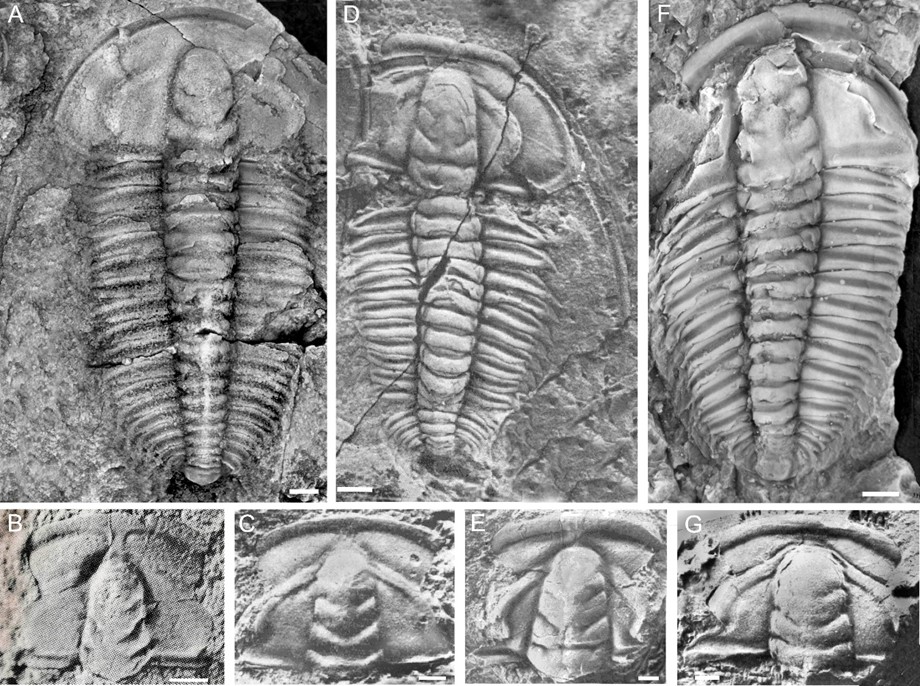Chiungchussu Fm
Type Locality and Naming
The type section of the Chiungchussu Formation is Guanshan section (102°37’E, 25°07’N). Guanshan is a small hill, on the northern slope of which the famous Qiongzhusi Temple was built. The section lies about 12 km west of Kunming City and was measured by Lu (1941), and remeasured by Luo et al. (1994). In this section, the Chiungchussu Formation is 193.67 m thick. The Chiungchussu Formation was named by Lu (1941). The name is derived from Chiungchussu (spelled Qiongzhusi in Hanyu Pinyin) Temple, Wuhua District, Kunming City, eastern Yunnan Province. Afterwards, this unit was adopted as a Chinese standard Cambrian chronostratigraphic unit, the Chiungchussuan Stage (Xiang et al., 1981; Zhang, 1985; Compiling Committee for Chinese Stratigraphic Lexicon et al., 1999), and had been used for a long time until a new four-fold chronostratigraphic subdivision was introduced (Peng, 2000a, b).
Synonym: (筇竹寺组); The type section is divided into two members, the Shiyantou Member below, which is a replaced name for the occupied Badaowan Member, and the Yu’anshan Member above.
Lithology and Thickness
The Chiungchussu Formation is basically a fine clastic sequence. The lower Shiyantou Member, 56.51 m thick, consists of black thin-bedded phosphatic pelitic siltstone in the lower part, with a layer of 0.4 m thick of nodular glauconitic, siliceous phosphorite and clayey shale at the base, a marker bed for defining the formation’s base, and grey to dark grey thin- to medium-bedded pelitic and dolomitic siltstone, intercalated with silty dolomite, in the middle and upper parts. The upper Yu’anshan Member, 137.16 m thick, consists of black thin-bedded silty, carbonaceous pelitic shale in the lower part, with a layer of 0.2 m thick greyish black sandy breccioid bioclastic phosphorite at the base, a marker bed for defining the member’s base, and yellowish green shale intercalated with thin-bedded sandstone in the middle and upper parts.
Relationships and Distribution
Lower contact
The Chiungchussu Fm is in disconformable contact with the underlying Tongying Fm. Its lower boundary is defined by the appearance of marker bed of nodular glauconitic, siliceous phosphorite and clayey shale, which rests disconformably on the underlying sandy dolomite of the Zhongyicun Member of Tongying Fm.
Upper contact
It is conformably overlain by the Tsanglangpu Fm. The upper boundary of the formation is defined by the appearance of dolomitic, quartzose siltstone of overlying Tsanglangpu Fm.
Regional extent
The Chiungchussu Formation is exposed in the Yangtze Area of South China Region, distributed in eastern and northeastern Yunnan Province and eastern Sichuan Province in the western part of Yangtze platform of South China Region. In eastern and northeastern Yunnan, the formation is widely distributed and stable in lithology with thickness ranging between 126 and 400 m. In southern Sichuan, the formation is usually 160‒297 m.
GeoJSON
Fossils
In the type section, the Chiungchussu Formation yields trilobites Eoredlichia intermedia, E. yaoyingensis, Yunnanocephalus yunnanensis and Y. reedi; bradoriids Kunmingella costata, K. diandongensis, K. maotianshanensis, Mononotella subquadrata and Songlinella yunnanensis; brachiopod Diandongia pista, D. sp.; hyolithids Ambrolinevitus meishucunensis, A. ventricosus, Hyolithellus incans, and Nenatheca dolosa; bivalve Isoyes sp.; small shelly fossils Archiasterella pentactina, Tanuolina multifera; and trace fossils Athrolinevitus meishucunensis, Arthrophycos qionzhusiensis, and Planolitesdolosa. In other localites, the formation yields trilobite Badiella, Tsunyidiscus, Kuanyangia and Wutingaspis.
The small shelly fussils occur in the lower part of the formation, and trilobites Abadiella, Tsunyidiscus, and Wutingaspis kunyanensis occur in the middle part of the formation (Abdiella Zone), and Eoredlichia intermedia, Wutingaspis tingi, and Yunnanocephalus yunnanensis occur in the upper part of the formation (Eoredlichia-Wutingaspis Zone).
Except for the trilobite and small shelly fossils, the Chiungchussu Formation yields also diverse fossils of other groups, known as Chengjiang Biota, including algae, sponges, cnidarians, nematomorphs, priapulids, anomalocaridids, brachiopods, hyolithids, lobopods (onychophorans), echinoderms, bradoriid and other non-trilobite and non-bradoriid arthropods.
[Figure: Some index fossils of the Chiungchussu Formation. A−C, Abadiella houi (Zhang, 1966), exoskeleton, cranidium, cranidium, from the Abadiella houi Zone, Mianxian, southern Shaanxi Province (A, C) and Meishucun, eastern Yunnan Province (B), B was assigned as holotype of Parabadiella yunnanensis by Luo et al., 1994); D, E, Eoredlichia internedia (Lu, 1940), exoskeleton, cranidum, from the Eoredlichia-Wutingaspis Zone, Wuding, northern Yunnan Province; F, G, Wutingaspis tingi Kobayashi 1944, exoskeleton, cranidum, from the Eoredlichia-Wutingaspis Zone, Wuding, northern Yunnan Province. All scale bars = 2 mm.]
Age
Depositional setting
Additional Information
